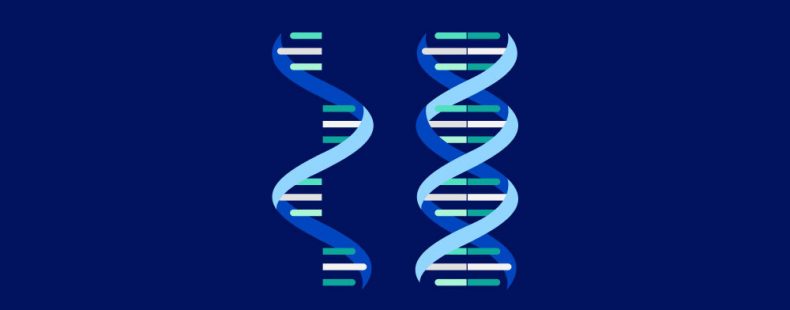COVID-19 has set off many unprecedented events that will most likely change the world forever. Fortunately, they haven’t all been bad: the virus led to the remarkable development of vaccines at a pace and scale the likes of which have never before been seen in history. Both the Pfizer-BioNTech vaccine and the Moderna vaccine use a relatively new technology that has been approved for the first time: mRNA vaccines. (The Oxford vaccine instead uses genetic material from what’s known as an adenovirus derived from chimpanzees.)
Arm yourself with more details about the Oxford vaccine known as ChAdOx1 nCoV-19.
These incredible developments, naturally, have led many people to dust off those old biology textbooks and try to remember what they learned about mRNA back in Biology 101. What do all those letters in mRNA stand for? How is it different from RNA? For that matter, what even is RNA? Does it have anything to do with DNA? In this article, we will answer all of these questions.
But first, we should quickly answer the most pressing question you might have: is it safe to take the COVID-19 vaccines or any mRNA vaccine? The answer is “Yes.” The new COVID-19 vaccines have gone through the same rigorous testing process as every other vaccine, as will any new mRNA vaccines developed in the future. If you’d like to know more about how the COVID-19 vaccines were tested for safety and approved, you can read about them in more detail as provided by the CDC and the WHO.
What is DNA?
To begin with, we must start with probably the best known of the three macromolecules (“big molecules”) we will be looking at today: DNA.
DNA stands for “deoxyribonucleic acid.” DNA is a large, complex molecule that carries and passes down the genetic code that makes up all living organisms. Because most people are at least somewhat aware of DNA’s very important role in life, DNA has come to metaphorically refer to “the set of nongenetic traits, qualities, or features that characterize a person or thing.” For example, we would say a love of words is part of the DNA of Dictionary.com.
DNA is found in the nucleus of cells of all living organisms. DNA is arranged in the shape of a double helix, which resembles a twisted ladder. The “rungs” of the ladder consist of base pairs of substances known as nitrogen bases. You might remember the four bases from science class: adenine, thymine, guanine, and cytosine. These base pairs are the reason why DNA is so important to life: the ordering of the base pairs results in a specific genetic code called a gene.
DNA consists of many genes and is itself organized into structures known as chromosomes, of which humans have 23 pairs. A fruit fly has four pairs of chromosomes, while a dog has 39 pairs. The genetic code in the genes and DNA tell the body how to make proteins. Proteins are extremely important for the survival of the body and you would be in big trouble if your cells couldn’t make proteins or accidentally made the wrong proteins.
We have merely scratched the surface of the complicated molecule that is DNA. To get a better idea of how important DNA is, here are some vocabulary words that explore concepts that are related to DNA:
- RNA (we’ll be getting to this one shortly)
- nucleic acid
- nucleotides
- nitrogen base
- genes
- genetics
- protein
What is RNA?
RNA stands for “ribonucleic acid.” RNA is a large molecule made from a single strand of DNA, and one of its main roles is to transfer the instructions needed to make proteins.
While DNA has the instructions on how to make proteins, it is RNA that actually provides these instructions to the ribosomes, organelles in the cell that act as “protein factories” You see, DNA never actually leaves the cell’s nucleus. The nucleus instead builds a single-threaded molecule called RNA, which has a copy of the DNA’s instructions. Like DNA, RNA also has nitrogen bases that act as a code that the cell can read. The RNA then takes the copy of the instructions and delivers them to the ribosomes. There, RNA helps the ribosomes properly build the correct proteins that the body needs.
As you might guess, this is a simplified version of what actually happens in the cells. To get a better idea of what is actually going on with RNA, here are some vocabulary words that provide more details on the concepts surrounding RNA:
- DNA
- transcription
- ribosome
- protein
- amino acid
- protein synthesis
- mRNA (we’ll be getting to this one)
- tRNA
- rRNA
DNA vs. RNA
DNA and RNA are very similar. After all, RNA is supposed to be a copy of DNA. However, there are a few differences between the two molecules.
- The biggest difference is in their shape: DNA is a two-stranded molecule in the form of a double helix. RNA, on the other hand, is a single-stranded molecule.
- The other major difference is in the nitrogen bases: RNA shares three of DNA’s bases but has a substance known as uracil that replaces thymine when the DNA is copied. To put it very simply, uracil requires less energy to maintain than thymine, but the presence of thymine makes DNA more stable.
What is mRNA?
There are several different types of RNA. One type of RNA is known as mRNA, which stands for “messenger RNA.” mRNA is RNA that is read by ribosomes to build proteins.
While all types of RNA are involved in building proteins, mRNA is the one that actually acts as the messenger. It is mRNA specifically that has the recipe for a protein. The mRNA is made in the nucleus and sent to the ribosome, like all RNA. Once it gets there, the mRNA bonds with the ribosome, which reads the mRNA’s nitrogen base sequence. Every three-bond sequence of mRNA relates to a specific amino acid, a “building block” of a protein. Amino acids must be arranged in a certain order to make a specific protein, and the mRNA has the blueprints that tell the ribosome which amino acids to get and how they should be arranged.
Other types of RNA, such as transfer RNA (tRNA) and ribosomal RNA (rRNA), help the ribosome actually build the protein. Once the protein is built, the mRNA’s job is over and it will degrade.
Again, this is a general look at what mRNA actually does. This list of vocabulary terms can help you learn more about mRNA’s job and about the other types of RNA.
How is mRNA used in COVID-19 vaccines?
Everything that has been said here doesn’t just apply to humans. Other organisms, including bacteria and viruses, also have DNA and/or RNA. The recent COVID-19 vaccines actually use mRNA from the virus itself in a rather sneaky way.
Usually, a vaccine uses a weakened or damaged version of a virus so that your body can have a “practice run” of fighting it. Your body will make antibodies that fight this weak form of the virus and thus will be able to recognize this same virus in the future and be able to quickly react to the real virus if ever exposed to it.
An mRNA vaccine works differently. Rather than inject a person with the actual virus, this type of vaccine instead injects the cells with some of the virus’s mRNA. This mRNA contains instructions on how to build “spike protein,” meaning the protein that is found on the spiky surface of a virus. This protein is harmless and has no ill effects on the body.
So, your cells will begin making this harmless spike protein. Your immune system will then recognize that this spike protein doesn’t belong in your body and make antibodies designed to destroy it. Making a long story short, this means your body will be able to recognize the spike proteins used by the actual virus. As a result, your immune system will immediately be able to make antibodies that swarm and kill the virus if it ever detects the spike protein in the body.
Luckily, you don’t have to become an expert in macromolecules for your body to function—or the vaccine to do its job. Your body automatically performs the complex functions described here to keep you alive. (Perhaps mastering some of the key terms associated with them is the least you could do!)














